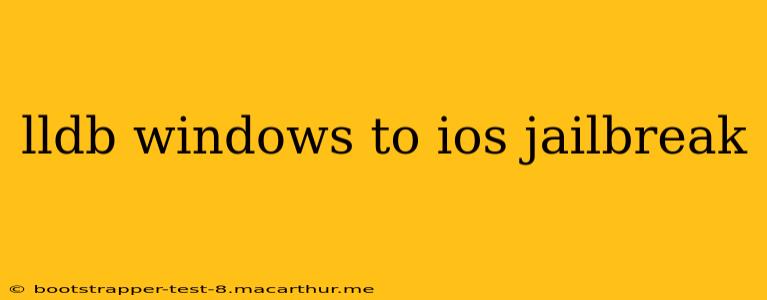Leveraging LLDB for iOS Jailbreak Development: A Deep Dive
The world of iOS jailbreaking is a complex one, attracting both security researchers and enthusiasts alike. LLDB, the powerful debugger, plays a crucial role in this process, allowing developers to meticulously examine and manipulate the inner workings of the iOS operating system. This guide explores the capabilities of LLDB within the context of iOS jailbreak development, addressing common questions and providing insights for those interested in this specialized field.
While LLDB itself isn't directly involved in the execution of a jailbreak, it's the primary tool used for understanding and manipulating the system during the development process. Understanding its use is critical for anyone looking to explore or contribute to iOS jailbreaking. We'll move beyond simple debugging tutorials and delve into the techniques employed by experienced jailbreak developers.
What is LLDB and why is it important for iOS jailbreak development?
LLDB is a sophisticated debugger that allows developers to inspect and manipulate the state of a running program. In the context of iOS jailbreaking, this means developers can:
- Inspect memory: Examine the contents of memory locations, crucial for understanding data structures and identifying vulnerabilities.
- Set breakpoints: Pause execution at specific points in the code, allowing developers to analyze the program's state at that precise moment.
- Step through code: Execute code line by line, observing the effects of each instruction.
- Modify memory: Directly change the values of variables and memory locations, a powerful technique for exploiting vulnerabilities.
- Reverse engineer code: Understand the functionality of compiled code by analyzing its behavior using LLDB's features.
These functionalities are fundamental to reverse-engineering iOS, identifying security flaws, and ultimately developing jailbreaks. Without a tool like LLDB, navigating the intricacies of the iOS kernel and other system components would be extremely challenging.
How do I use LLDB with a jailbroken iOS device?
Using LLDB with a jailbroken device typically involves utilizing tools like gdb or a custom debugging interface built within a jailbreak environment. This process usually involves:
- Connecting to the device: Establishing a connection between your computer and the jailbroken device, often via USB.
- Launching a debugger: Initiating the debugging session using a compatible debugger client.
- Attaching to the target process: Connecting the debugger to the specific process you want to analyze. This might be a system process like
launchdor a custom application. - Using LLDB commands: Employing various commands to inspect memory, set breakpoints, step through code, and modify values.
The specifics heavily depend on the chosen jailbreak and the desired debugging objective.
Can I use LLDB on a non-jailbroken device?
No. LLDB requires access to the system's memory and processes, which are restricted on non-jailbroken devices. Jailbreaking grants the necessary privileges to utilize LLDB effectively for iOS system-level analysis.
What are the ethical considerations of using LLDB for iOS jailbreaking?
The ethical implications of iOS jailbreaking are complex. While jailbreaking can enable users to personalize their devices and explore the operating system's functionality, it can also be exploited for malicious purposes. It’s crucial to use this knowledge responsibly and ethically. Remember that unauthorized access to a system can have severe consequences.
What are some common LLDB commands used in iOS jailbreak development?
Many commands are utilized, but some of the most frequently used include:
image list: Lists loaded images and their memory addresses.memory read: Reads data from a specific memory address.memory write: Writes data to a specific memory address.breakpoint set: Sets a breakpoint at a specific address or function.register read: Reads the values of CPU registers.x/: Examines memory in various formats.
Mastering these commands is fundamental to effective use of LLDB in this context.
This guide offers a starting point for understanding LLDB's critical role in iOS jailbreak development. Further exploration into specific techniques and tools will require dedicated research and a firm grasp of low-level programming concepts. Always remember to proceed with caution and respect the legal and ethical implications of your actions.
